Trees Birds Mammals Fish Amphibians Reptiles
Wild Algarve
Bookshop
Lepista sordida (Sowerby) Pat.- Sordid Blewit
Phylum: Basidiomycota - Class: Agaricomycetes - Order: Agaricales - Family: Tricholomataceae
Distribution - Taxonomic History - Etymology - Identification - Culinary Notes - Reference Sources
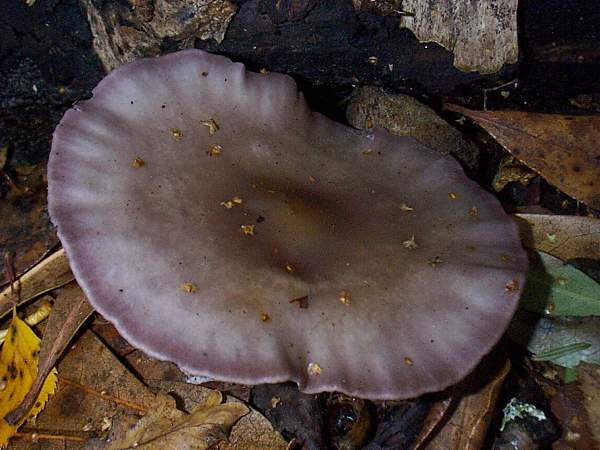
A somewhat smaller and less robust mushroom than the Wood Blewit, and with deeper violet colours and a thinner cap margin when mature, Lepista sordida is not easily separated from Lepista nuda. To make matters worse this thin-fleshed member of the Lepista genus occurs in some of the same habitats.
Often the colour of this mushroom is deep violet, and then it could easily be confused with the Violet Webcap Cortinarius violaceus.
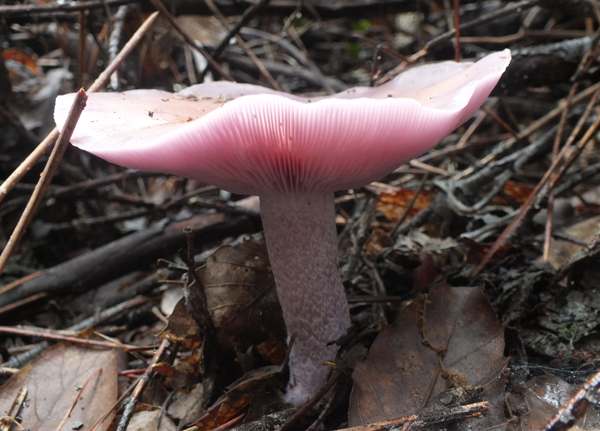
Distribution
Fairly common and widespread in Britain and Ireland, although not seen as frequently as the Wood Blewit Lepista nuda, Lepista sordida is found throughout most of mainland Europe. In common with Wood Blewits and Field Blewits, Lepista sordida is also reported from North America. (Field guides published in the USA may - Classify this species under the synonym Clitocybe tarda Peck.)
Taxonomic history
This mushroom was described in 1821 by the great Swedish mycologist Elias Magnus Fries, who gave it the binomial scientific name Agaricus sordidus.
It was not until 1949 that the currently-accepted scientific name was established, when German-born mycologist Rolf Singer redescribed this mushroom as Lepista sordida.
Synonyms of Lepista sordida include Agaricus sordidus Fr. Tricholoma sordidum (Fr.) P. Kumm., Gyrophila nuda var. lilacea Quél., Rhodopaxillus sordidus (Fr.) Maire, Lepista sordida var. sordida (Fr.) Singer, Rhodopaxillus sordidus f. obscuratus Bon, Lepista sordida var. ianthina Bon, Lepista sordida var. lilacea (Quél.) Bon, and Lepista sordida var. obscurata (Bon) Bon.
Etymology
Lepista is derived from Latin and means a wine pitcher or a goblet, and when fully mature the caps of Lepista species often do become concave (sometimes referred to as being infundibuliform) like shallow chalices or goblets. Rather as it sounds, the specific epithet sordida simply means sordid (in the sense of dingy, filthy or foul).
Identification guide
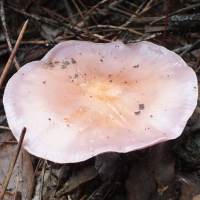 |
Cap
3 to 8cm across; initially convex, flattening out or developing a central depression at maturity, usually with a slight umbo and a wavy margin; deep lilac, turning brown from the centre in dry weather. |
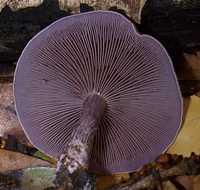
|
Gills
Sinuate or emarginate and crowded, the gills are initially greyish lilac fading to buff with age.
Stem
4 to 6cm long and 5 to 8mm dia.; fibrillose; lilac; downy and white at base; no ring. |
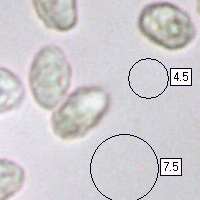 |
Spores
Ellipsoidal, 6-9 by 4-5µm; ornamented with tiny spines.
Spore print
Creamy-white to very pale pink. |
Odour/taste |
Slightly scented; mild taste is slightly floury but not distinctive. |
Habitat & Ecological role |
Saprobic, in mixed woodland usually in areas where leaf litter collects and rots; also in flower or vegetable gardens and sometimes on compost heaps. |
Season |
June to October in Britain and Ireland. |
Similar species |
Lepista nuda, the Wood Blewit, is a more common species; it is very
similar but has a more robust and fleshy cap. |
Culinary notes
Although not generally sought for its culinary properties, Lepista sordida is an edible mushroom and can be used in the same way as Field Blewits and Wood Blewits. These mushrooms are edible only if well cooked, however, and even then it is a wise precaution to try a very small portion at first because they have been known to disagree with some people. Never eat them raw. Blewits may not be top of the esculentary scale, but they do have one big advantage: long after Field Mushrooms, Chanterelles and most other popular edible fungi have all disappeared several kinds of edible blewits are
still plentiful.
Reference Sources
Fascinated by Fungi, 2nd Edition, Pat O'Reilly 2016, reprinted by Coch-y-bonddu Books in 2022.
Funga Nordica: 2nd edition 2012. Edited by Knudsen, H. & Vesterholt, J. ISBN 9788798396130
Dictionary of the Fungi; Paul M. Kirk, Paul F. Cannon, David W. Minter and J. A. Stalpers; CABI, 2008
Taxonomic history and synonym information on these pages is drawn from many sources but in particular from the British Mycological Society's GB Checklist of Fungi.
Top of page...
Fascinated by Fungi. Back by popular demand, Pat O'Reilly's best-selling 450-page hardback book is available now. The latest second edition was republished with a sparkling new cover design in September 2022 by Coch-y-Bonddu Books. Full details and copies are available from the publisher's online bookshop...